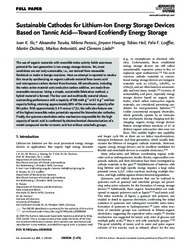Sustainable Cathodes for Lithium‐Ion Energy Storage Devices Based on Tannic Acid—Toward Ecofriendly Energy Storage
Ilic, Ivan K.
Tsouka, Alexandra
Perovic, Milena
Hwang, Jinyeon
Heil, Tobias
Loeffler, Felix F.
Oschatz, Martin
Liedel, Clemens
DOI: https://doi.org/10.1002/adsu.202000206
Persistent URL: http://resolver.sub.uni-goettingen.de/purl?gldocs-11858/8465
Persistent URL: http://resolver.sub.uni-goettingen.de/purl?gldocs-11858/8465
Ilic, Ivan K.; Tsouka, Alexandra; Perovic, Milena; Hwang, Jinyeon; Heil, Tobias; Loeffler, Felix F.; Oschatz, Martin; Antonietti, Markus; Liedel, Clemens, 2020: Sustainable Cathodes for Lithium‐Ion Energy Storage Devices Based on Tannic Acid—Toward Ecofriendly Energy Storage. In: Advanced Sustainable Systems, Band 5, 1, DOI: 10.1002/adsu.202000206.
 |
Dokument öffnen: |
The use of organic materials with reversible redox activity holds enormous potential for next‐generation Li‐ion energy storage devices. Yet, most candidates are not truly sustainable, i.e., not derived from renewable feedstock or made in benign reactions. Here an attempt is reported to resolve this issue by synthesizing an organic cathode material from tannic acid and microporous carbon derived from biomass. All constituents, including the redox‐active material and conductive carbon additive, are made from renewable resources. Using a simple, sustainable fabrication method, a hybrid material is formed. The low cost and ecofriendly material shows outstanding performance with a capacity of 108 mAh g−1 at 0.1 A g−1 and low capacity fading, retaining approximately 80% of the maximum capacity after 90 cycles. With approximately 3.4 V versus Li+/Li, the cells also feature one of the highest reversible redox potentials reported for biomolecular cathodes. Finally, the quinone‐catecholate redox mechanism responsible for the high capacity of tannic acid is confirmed by electrochemical characterization of a model compound similar to tannic acid but without catecholic groups. Tannic acid and sucrose‐derived porous carbon are combined to create a hybrid material using ball milling. The sustainable hybrid material shows exceptional properties as a cathode material for lithium‐ion energy storage devices that combines energy storage using both a redox process, from tannic acid, and electric double‐layer capacitance, from the porous carbon.
Statistik:
ZugriffsstatistikSammlung:
This is an open access article under the terms of the Creative Commons Attribution License, which permits use, distribution and reproduction in any medium, provided the original work is properly cited.

